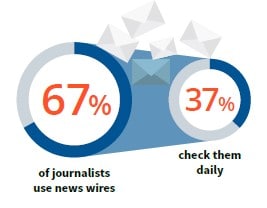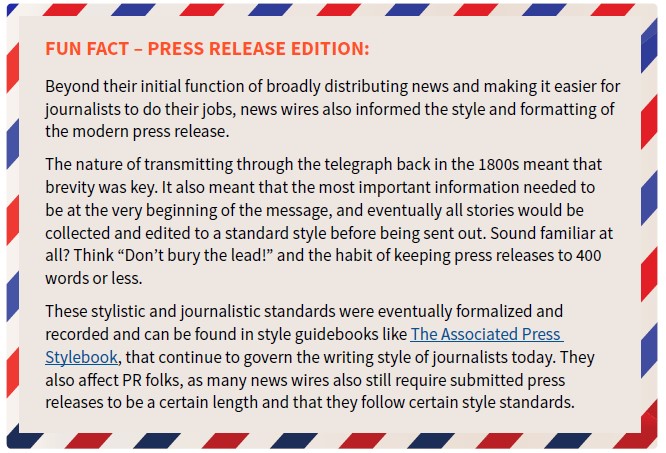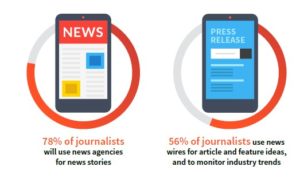Newswires 101: Everything You’ve Ever Wanted to Know
A NEWSWIRE distribution is a press release sent out to major media outlets by a commercial newswire service or news agency. Marketing and public relations professionals use newswire distributions with the aim of generating coverage on major news outlets, increasing brand awareness, reach, and visibility, and in some cases to boost search engine rankings.
Imagine you’ve just been called into your boss’s office. They want you to tell them about news wires: How do they work? How much do they cost? Should we be using one?
Would you be able to answer one or any of these questions? Or would you sit there frozen like a deer in the headlights whilst seriously considering your odds of effectively escaping by pretending to faint? For a public relations tool that’s been around for an awful long time (I’m talking “Extra! Extra! Read all about it!”-and-earlier long time), there tends to be quite a bit of confusion surrounding the infamous news wire.
At its core, the premise is very basic, and while it was at one time an essential tool for journalists and companies who wanted the press to be notified of their activities and statements, you can now find quite a collection of articles today arguing for or against their relevance in today’s PR world.
But love’em or hate’em news wires are still kickin’, and it’s important that public relations professionals have a solid grasp of what they are, how they’ve evolved, and how best to use them in order to make an informed decision on how, or if, they should be included in a communications strategy.
So let us help clear up the cobwebs around this perhaps not-so-dated PR tool and explain everything you’ve ever wanted to know about news wires and the public relations industry.
What even IS a news wire?
First and foremost, let’s appease our inner word nerd and get a baseline definition from our friends over at Merriam-Webster.
News wires (aka newswires, wire services, news agencies, “the wire”) (n.):
A news agency that sends out syndicated news copy
to subscribers by wire or by satellite transmission.
And what is “syndicated news copy” you ask? It’s essentially a fancy way of saying that lots of different news outlets and journalists have access and the rights to use the same content originally published somewhere/by someone else.
Where confusion often lies is in the fact that there are essentially two types of news wire services. Both originate from the same place and have a similar function (of widely distributing news), but they focus on different material and one has far more relevance for PR practitioners than the other. Since the same language is often used to refer to both, for the sake of this piece, we’ll categorize them like this:
News Agencies
If you’re a news junkie and read multiple news sources a day, you may notice sometimes that there is an article repeated almost word for word in more than one publication. That’s because the story originates from a wire service. News agencies like Reuters, Bloomberg, and the Associated Press (AP) hire journalists to write original articles that are published on the wire and picked up by a variety of subscribing news outlets. These articles will always have the journalist’s name included, and the news agency they work with.
In today’s changing and competitive media landscape, many outlets now rely on news agencies to provide their baseline news copy. This allows the outlet to employ fewer reporters and redirect resources instead to creating more robust editorial content to give the publication its unique flavour and characteristic “voice”.
Pitching a news agency journalist successfully is striking media relations gold. The downside? To say it’s a “tough sell “would be an understatement. These journalists are typically swamped, even more than the norm, and have no shortage of news stories, as they often cover breaking news and current events.

Agility PR Solutions’ integrated news wire platform
Press Release Feeds
What most PR professionals will be referring to when they mention “the wire” or a “news wire”, is essentially a press release feed. These are wire services that (usually for a fee) will post press releases from companies that subscribing journalists and outlets can access.
Agility PR Solutions’ integrated newswire is a great example of a press-release-feed style newswire that distributes press releases to a broad range of news outlets and journalists.
There are also wire services that will post both original news stories AND press releases, like Press Association (PA).
Ok great, so what does it all mean?
News wires of all varieties were invented to help journalists do their job more effectively, and most are subscribed to both news-agency and press-release-feed news wires. In fact, according to a study by Vitis Business Consulting, despite being quick to point out their flaws, 67 per cent of journalists use news wires with as many as 37 per cent checking them daily.
both news-agency and press-release-feed news wires. In fact, according to a study by Vitis Business Consulting, despite being quick to point out their flaws, 67 per cent of journalists use news wires with as many as 37 per cent checking them daily.
As such, they’re worth understanding and considering when crafting media relations strategies for your organization or clients.
So where to start? Well if we want to properly grasp some of the basics that define media relations and news wires today, we’ve first got to understand what defined them in the past.
Once Upon a Time…
 By now you’ve probably guessed that we’ll be embarking on a mini history lesson, and yes, we did hear you audibly “groan” when you came to that realization. But, the good news is we’ll be brief, and it involves carrier pigeons! Yeah that’s right, carrier pigeons. Can’t get much better than that!
By now you’ve probably guessed that we’ll be embarking on a mini history lesson, and yes, we did hear you audibly “groan” when you came to that realization. But, the good news is we’ll be brief, and it involves carrier pigeons! Yeah that’s right, carrier pigeons. Can’t get much better than that!
With our 24/7 news cycle and tech-dependent media landscape, it’s easy to forget that at one time, transmitting news from one location to the next was a multi-day affair. Without the benefit of the Internet, fax machine, or even a telephone, the early-mid 1800s were characterized by news being dependent on postal service and reporters going down to the docks in major coastal cities like Boston and New York to get transatlantic news from the ships arriving in port. But what about the reporters who didn’t live in a coastal city where they could access international news? And never mind international news, how did anyone quickly and efficiently find out about anything going on outside of their own city? Key words: “quickly” and “efficiently”.
Until the mid 1800s, news had to be transmitted through letters and the national postal service. Well, in 1846, five New York City newspapers decided that method wasn’t fast enough. Together they formed the Associated Press to create an express pony trail that would get news of the Mexican War to the northern United States quicker than the post. Shortly after, the Associated Press would have an even more effective tool at their disposal.
Enter the telegraph. The telegraph, developed by Samuel Morse (Morse code anyone?) in the 1830s and 1840s, allowed users to transmit and receive messages over long distances using wire and electricity. Telegraphs became a staple of news rooms world wide and were used to communicate news with each other. If a wire didn’t exist to connect certain cities, that’s where the carrier pigeons came in. In fact Reuters, now an internationally recognized news agency, began as a bird service, using pigeons to transmit messages between Brussels, Belgium and Aachen, Germany until the telegraph finally connected the two in the mid 1800’s.
As for international news, reporters still had to go down to the docks to meet the ships before heading back to transmit via telegraph to other news rooms in the region, until the first transatlantic wire came into permanent operation in the 1860s.
Since the telegraph’s transmission capacity was limited, the press discovered quite quickly that it was in their best interest to pool news-gathering, instead of competing for transmission over an already-crowded service.
The continued existence of multiple wire services proves that the benefits of news-pooling is still as relevant now as it was well over one hundred years ago.

How Newswire Work Today
Perhaps you’re asking yourself “Well that’s all fine and good, but what does any of that history have to do with me and my comms strategy?!”.
Well aside from the origins of common press release style and best practice, the history of the newswire also gives us an excellent idea of why journalists continue to use them, and clues to PR pros on how best to utilize them. More on that later!
In the meantime, let’s take a look at how the modern news wire works, as I’m sure you’ve deduced that we don’t continue to rely on telegraphs or carrier pigeons (sadly).
Largely relying on the Internet, news wires today distribute submitted press releases electronically for a fee to subscribing newsrooms and journalists. There are global wires and regional wires that distribute to specific markets. For example, a wire service may have a North American wire, a US-only wire, or a UK-Europe wire that distribute releases only to the subscribing outlets in that region. The company submitting their press release will be able to choose which regional wire they’d like to use.
Once posted to the wire, journalists and news outlets who subscribe to that particular wire will be able to see it. However, depending on the size and popularity of the wire, there can be tens of thousands of press releases posted a day. While many wires will allow journalists to filter releases based on topic, there is always a massive amount of content to sift through.
Subscribing journalists and newsrooms can monitor the wire through email alerts or they may simply check the wire on a regular to semi-regular basis. While a large majority of wire subscribers (78 per cent) will use news agencies for news stories, according to Vitis Business Consulting’s survey, 56 per cent of journalists use news wires for article and feature ideas, and to monitor industry trends. Which is good news for PR folks!

In some cases, especially in the financial sector, news outlets will have a section of their website that will automatically pick up any press releases distributed on the wire that include a stock market ticker symbol. Publicly traded companies are legally required to wire-publish news that will affect their investors, and the ticker symbol is a necessary component of their press release. So while that could be considered an easy “win” when it comes to scoring coverage, it’s worth noting that these pages don’t often get very many views, and getting the press release picked up on a site is not the same as earning coverage from a journalist.
In fact, when researching newswires, you’ll want to be conscientious of what numbers are being used to try and woo you. Many wire services simply tabulate their subscribing news outlets’ websites’ total monthly users to quantify their reach and influence, which will ultimately sound extremely high and impressive, as opposed to looking at how many people on average actually view the press releases.
Pricing
While free wire services do exist, you typically get what you pay for when it comes to their reach and influence. Most journalists have certain wires that they prefer over others due to the quality and relevance of the press releases they deliver, and if you want your news wire efforts to have any meaningful impact, those paid news wires are the ones you’ll likely want to pursue. But as with anything else, do your homework!
Most of the quality news wire services publish company news releases for a fee. This can range anywhere from $150 up to $1000+ depending on your press release’s word count and number of images, videos, logos, and whether or not you need it to be bilingual (we see you Canadian PR folks!). Many pricing models include a fee for a press release with a set number of words and images, and then charge a premium for additional words and multimedia components. Other wire services, like Agility PR Solutions’ integrated news wire, work on a flat fee system, where there is one price regardless of the length, word count, or number of logos/multimedia components in the press release.
Because you’ll likely end up having to invest money if you choose to include news wire in your strategy, the age-old conundrum remains: To news wire? Or not to news wire? That is the question.
What Newswire CANNOT Do
So why bother posting your press release to the news wire if it costs you money and doesn’t even guarantee earned coverage or a significant SEO boost?
Allow us to point out their more attractive qualities:
 Broad media relations strategy
Broad media relations strategy
As part of a larger media strategy, news wires allow you to go broad. It has the potential of getting your news release in front of a large number of eyes, many of whom you may not have thought of right away when putting together your strategy. Also, because certain wire services and news outlets automatically pick up certain press releases, you can exponentially increase the chances of being noticed. And while this may not get you earned coverage on its own, it does help with things like…

Brand recognition
Even if they choose not to write a story, if you put out quality press releases (keyword: quality) on a semi-regular basis, journalists may become more familiar with your brand/company, putting you on their radar, and increasing the chances of having someone reach out eventually or respond favourably to direct outreach.

Support more targeted media relations strategies
Putting your release on the wire can support your more targeted media relations strategies, especially with industry-specific journalists. Having your release out on the wire gives you something to reference when speaking with your contacts and may jog their memory.

Industry-focused journalists do make good use of news wires
Journalists who write for specific industry and trade publications do tend to monitor news wires more closely than their mainstream counterparts. With fewer news tips constantly flooding their inbox, as is the case for editors and journalists working at more mainstream publications, industry writers will commonly use news wires for story ideas and news tips related to their field.

Fact checking
Many journalists will use news wires as a quick and easy way to verify information when fact checking articles for their publication. Your wire press releases can serve as a quality communications tool, complete with relevant facts, company boiler plate info, and links to visuals and other information beyond the scope of the release.
Tips For Using a Newswire
So you’re thinking of incorporating the news wire into your media relations strategy? Here are some tips to make the most of them:
Make sure your press release is actual news
Journalists often complain about the sheer volume of press releases that hit the wire every day and the effort it takes for them to wade through it all. For their sake, make sure that if your company is choosing to publish a press release, that it is in fact news. While it may seem basic, this is a common mistake companies make, and when the time comes that you have genuinely exciting or important news to share, you risk getting overlooked.
Quality content
In that same vein, you’ll want to make sure your press release stands out and includes quality content. Include relevant links, visuals, multimedia whenever possible, and most importantly, a killer headline. Want some help creating an impossible-to ignore press release? Check out our guide here.
Include your ticker symbol
If you’re simply looking for the broadest potential reach possible, include your ticker symbol so that your release is picked up by the websites that syndicate to wire services.
Style accordingly
Again, make journalists’ lives a little bit easier and style your press release according to your region’s style guide (i.e. The Associated Press Stylebook, The Canadian Press Stylebook etc.).
Specify your region, release time, and time zone
When distributing on the wire, make sure you specify which region you want, the specific time you want it released (typically, early in the morning i.e. 6:00 am is best) and the time zone. Do not forget to specify the time zone! Make sure it’s set for the correct time in whatever region you’re distributing, as it may be different from your own.
Be ready to follow up
Remember, putting a press release out on the wire will not guarantee you journalist calls. Figure out your targeted list, and once your release is out, follow up!
The Press Release Life Cycle
So you’ve written your killer press release, chosen your wire demographic, and your media strategy is ready to launch. So when and where do you publish your release first?
The Exclusive Scoop
If your media strategy involves pitching an exclusive story to a specific journalist or publication DO NOT post it on the wire. Period. News wires are for broad media relations only, and you’ll likely get blacklisted by a journalist if you’ve offered them an exclusive, only for them to see that you’ve posted it for every other journalist in the region to see on the wire.
Under Embargo
“Under Embargo” simply means that the press release cannot be shared with the public before a specific time. These press releases will have the words “Under Embargo Until *time*” on the press release itself. This alerts journalists that they cannot publicly discuss or publish anything until that time.If your press release is under embargo.
DO NOT post it on the wire right away. Most news wires will allow you to schedule when you’d like for it to be released. Make sure this time lines up with the embargo you’ve included on your press release, otherwise, your metaphorical cat will be out of its metaphorical bag.
In this case, you’d share the release with your targeted journalists first, to give them time to digest the information and prepare the story, and then publish on the wire at the specified time for a wider release.
Average Lifecycle
Assuming you are not offering any journalists an exclusive chance to report on your story, and your press release is not under embargo, you will typically post your press release to the news wire before engaging in one-on-one follow-ups with targeted journalists.
A typical workflow will look something like this:

For more information on the lifecycle of a press release, check out our ultimate press release guide.
So there you have it! Everything you’ve ever wanted to know about news wires. We hope we’ve enlightened you on this often-times confusing topic, and that you can take this information with you and make informed decisions that are best for you, your media strategy, and your company.
To sum up the main takeaways one more time:
▶ News wires collect news stories, photographs, columns, and press releases and make them available to a broad network of subscribing journalists and news outlets.
▶ Not all news wires distribute both news stories and press releases. PR folks are typically referring to the wires that act as press release feeds.
▶ News wires have been around for a long time, and their main purpose hasn’t changed much. (Also, we probably all wish that carrier pigeons were still somehow involved…)
▶ News wires were created to make journalists’ jobs easier. That should also be your aim when using news wires. Distribute quality content and style accordingly.
▶ Most journalists do still use news wires, whether for fact checking, news ideas, or to monitor industry trends.
▶ Manage your expectations. News wires are a great supporting tool in a larger media relations strategy. They shouldn’t be the whole show.
Talk to us about our newswire service
Get in touch with us to purchase a single newswire or newswire bundle for additional savings.

